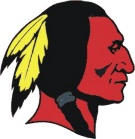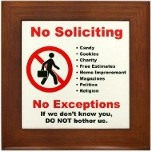Redface! |
 |
Redface in Film and TVIn early films, American Indians were almost always depicted as half-clothed savages, screaming war cries as they got shot off their horses by the white heroes. It's almost comical now, but that was the only Hollywood image of American Indians until the mid- to late-1970s; and it was exported to the entire world. Thomas Ince's Heart of an Indian (1912) showed Indians as sensitive people but DW Griffith's The Battle of Elderbrush Gulch (1914) presented the Indians as absolute savages. The Vanishing American (1925) and Broken Arrow (1950) present a "noble savage" stereotype.
The Indian woman of early films was depicted in only two categories. She was either a princess or a squaw. Either she was a dangerous and seductive threat to the white frontiersman, or she was the faceless, dutiful figure tagging along behind her buck with papoose in tow. Her only utterance was "Ugh." The word "squaw" means wife, but only through a very rough interpretation and in only one of the hundreds of Native American languages. The princesses of celluloid fame generally served the white man, fell in love with him, and died tragically. Early white male stars who played Indian roles in western film pantomimed their Indian-ness in braided wigs and make-up; likewise, established white actresses always played Indian princesses. Some of those seen bathing in the streams and in chic haute couture doeskin dresses were Yvonne de Carlo (The Deerslayer, 1943), Elsa Martinelli (Indian Fighter, 1955), Linda Darnell (Buffalo Bill, 1943), Debra Paget (Broken Arrow, 1950). In early Hollywood Westerns, most of the background Indians were real Navajo people. There was a colony of Navajo Indians living traditionally in a camp in Malibu who were on studio pay. When Indians of any tribe were needed for a western, a bus would pull up and load up for their background work. That is why in all those films, most of the time the language you hear spoken is "Dine," one of the Athapascan dialects of the Navajo and Apache people. The major speaking roles for American Indians would still go to non-Native actors like Burt Lancaster and Charles Bronson.
Progress has been gradual, but somewhat steady. Jay Silverheels -- a
native of the Six Nations of the Grand River reserve near Ontario,
Canada -- was perhaps the first legitimate Native American television
star. From 1949 to 1957, he entertained TV audiences as Tonto, the Lone
Ranger's dependable -- albeit stereotypical -- Indian sidekick. The real
Silverheels, though, was not limited by the stereotype. He recognized
that fellow Native American actors needed to truly be masters of their
craft in order to compete in the unforgiving film industry, so he
founded the American Indian Actors Workshop in Echo Park, Calif., as a
place where they could do that. In 1979, Jay Silverheels was the first
native American actor to be awarded a star on Hollywood's Walk of Fame. The Navajos in Monument Valley who worked on The Searchers -- as extras, consultants or other staff -- were paid less than their white counterparts. At that time, too, they were not even allowed to leave the reservation without written permission from the government; so the fact that they were happy to have the work must be viewed in that light. But Ford's efforts were progressive for his day and laid the groundwork for some of the more truly balanced movies to come.
It was in the 1970s that Indians began to be portrayed more
authentically and more prominently in film story lines. In Little Big Man
with Dustin Hoffman the native Americans are actually shown laughing and
crying, like real human beings rather than the stereotypical stoic and
unemotional Indians normally seen in Hollywood features. The Indians
were depicted just like any other people -- some good, some not so good.
Chief Dan George was nominated for a Best Supporting Actor Academy
Award, making him the first Native American to receive the honor.
Hollywood also had Iron Eyes Cody. His ancestry became the center of some controversy when it became known that he was actually Italian by birth. But he did not just work as an Indian in Hollywood in the 1950s and '60s; he truly lived his life as an Indian. He can be credited as the most famous Indian in the world during that time. Even though he was not born an Indian, we should not forget that Iron Eyes Cody raised awareness for the American Indian people and also of the importance of environmentalism (Keep America Beautiful Public Service ad campaign) in a way that no one else was able to do at that time.
Whether the noble Indian is shedding a tear for a 1960s' environmental
public service commercial or being saved by the great white hope Captain
John Smith in the recent Disney movie
Pocahontas, hints of self-pity and romanticism continue to
haunt American Indians in film. While Hollywood no longer portrays
American Indians as painted and uncivilized savages, waving tomahawks
and scalping the innocent European settlers, contemporary movies
maintain the stoic `Indian' image smothered with sentimentality. Russell Means, an American Indian activist who has played high profile parts in several movies including The Last of the Mohicans, Natural Born Killers, and Wagons East!, stated that "...as Americans we have faced up to many social ills. Anti-Semitism, racism against blacks, oppression of women, and now it's time to face up to the Indian issue." The American Indian Film Institute (AIFI) is a non-profit media arts center founded in 1979 to foster understanding of the culture, traditions and issues of contemporary Native Americans. In 1992 the Native American Producer's Alliance was created. |

Buy a No
Soliciting Sign
That Really Works!
|
|
|
|
|
Redface! -- ContentsRacist Indian StereotypesHistory of Indian StereotypesRedface in Film and TVIndian Myths vs RealityIndian Stereotypes in Sports |
|
|
|||||
|
|
|
|
|
|
|
Racial and Racist Stereotypes in Media |
|||||
|
|
|||||